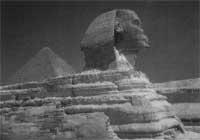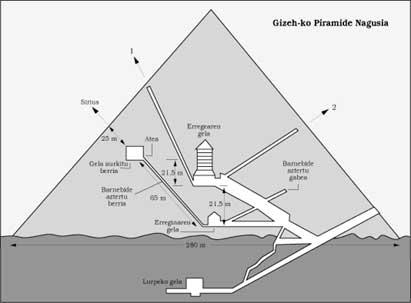Esfing Enigma
1993/03/01 Ezpeleta Arenaza, Txema | Laguéns Capablo, María Elena Iturria: Elhuyar aldizkaria
If you have ever been to Egypt, you would have noticed the attraction of its warm and large appearance. If you have heard of this territory through the books, his mysterious smile would provoke an emotion in you. In the area of the Pyramids of Gizeh is one of the most famous states in the world. The name is as enigmatic as its image.
To whom does the human head of the lion appear buried in the desert? Is it the pattern of the pyramids? The effect of the past years is evident in the Esfing and the deterioration due to the time must be added the currently caused by pollution. Fortunately, a restoration plan has recently come into force that will keep the mystery of Esfing.
State
Esfing is one of the most prestigious monuments in the world. Its dimensions are 22 m high and 80 m long. It is the only representative of this type of state and is the largest royal statue of Ancient Egypt. It is a king's head lion with statue, false beard and starched mantle (nemes). It is made in one piece and is carved directly on the rock, removing from it the excess stone.
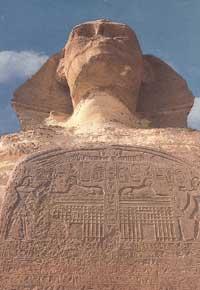
The current Esfing is the image of Kefren. This pharaoh, the builder of the Second Pyramid of Gizeh, is the son of Great Keops, who built the greatest tomb in history, the Great Pyramid of Gizeh.
According to most researchers, the Sphinx is the IV Ancient Empire. dynasty (a. C. 2613-2500), which took place at the time of Kefren, coinciding with the construction of his burial, representing the pharaoh as a conservation animal of the tomb. However, Mark Lehner (from the Eastern Institute of Chicago) believes that Esfing could be prior to Kefren.
The statue is located in the courtyard of a temple; to the right of the accesses to the Main Temple and the Pyramid of Kefren (later pharaohs placed funerary steles and built more temples in the surroundings).
In the New Empire (a. C. 1570-1070) Esfing became a symbol of monarchy and nation. Amenofis II built a symbol in the northeast of the state and placed inside the trail that informs us of the youth that has passed through Menfle: As he was a lavish fan of horse racing and the processors feared possible accidents, they informed Amenofis' father of their concerns; the Great Tutmes III. The king rejoiced greatly at his son's love and ordered all the horses of the stables to pass into the prince's hands. Therefore, Amenofis made with his horses the journey from Menfisti to Gizeh.
Tutmes IV and Ramses II also placed several stelae between the clutches of the Sphinx. Apparently, Ramsese placed his statue on the chest of the Sphinx. It is estimated that the image of Ramsese could have a height of 7.5 m. However, this is only an opportunity, since the found remains could belong to the states of a nearby temple.
The present Sphinx has lost the nose and false beard of the pharaohs. Apparently, a gunshot caused the disappearance of the nose in the campaign carried out by Napoleon in Egypt. The Mamluks used the state as a target for shooting practices. With these practices, in addition to improving the aim of canoilaris, an Islamic law was enforced that prohibits the representation of people and animals.
As for the beard, researcher Caviglia discovered between the two claws the remains of Sphinx's beard in 1816, but they were small fragments. Egyptian restorers have tried to design the beard, but how to do it without more than 15% of the original material? On the other hand, we all know Esfing and the beard without burrs, wouldn't it be a big debate?
Esfing Enigma
The origin and purpose of esfing are mysteries that surprise people and many stories have been written about it.
Already with esfing, the base rock was adorned in prehistory by its peculiar animal form. The craftsmen of the Old Empire worked the lion on the aforementioned rock. The lion with Pharaoh's head stretched over the belly, with legs stretched out and parallel to each other. In the New Empire, the state was called Hor-emakht (“Horus on the Horizon”). The Egyptians know him as Abu-Hol (“The Father of Terror”), a name derived from Bw hol (“The Place of Horus”).
In Egyptian mythology, Horus was the solar god. It was represented as eyes through a azor with the Sun and the Moon. Being Don Sol, around him appeared a solar disc surrounded by a snake. Later it adopts the human form, but the back of the head corresponds to that of the disturbed. All representations of the Egyptian gods were symbolic and should be understood as visual metaphors: Horus, who directs mankind, has the ability to feed the Sun through its wings so that the sun “navigates” daily through the sky.
Therefore, Esfing would represent Kefren, who is presenting gifts to the Sun (al Ra), while the Sun expects it to come out into darkness. In fact, the Temple of the Sphinx presents niches on its eastern and western sides for sunrise and sunset rites. It also has 24 columns indicating daily and night hours.
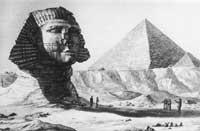
Esfing is an indicator of the elements of the Egyptian pantheon. The head can be human, decorated with burial baskets, or animal (azor or or ram). In the temples, the avenue (dromos) leading to the entrance pylon was surrounded by animal head sphinxes. Even in the divinities, including those outside Egypt, you can find sphinxes with king's head or princess. In the New Empire, perhaps due to the influence of the Asians, the sphinx appears lifted over the later parts. dynasty (B.C.) 1570-1293) representing the faces of the queens.
Although of Egyptian origin, the word sphinx is Greek (Sjigx). It is related to the monster born of the couple Tifon and Ekna. The monster was sent by Laio to take revenge on the Thebans for the kidnapping of Crisis. With this goal he stayed in the vicinity of the city of Thebes. There he stopped the travelers and proposed different enigmas, devouring those who did not succeed.
Esfing has fascinated several archaeologists. Some believe that under the state there is a temple. In 1816, an expert named Caviglia sought out the underground passage linking the Sphinx to the Great Pyramid, but did not find it. In 1978 two steps were found: one under the head and one under the tail, but then H was discovered. Researcher Vyse conducted a study in 1881. A few years ago they found another hole in the north. It seems that the “secret gateways” are those made by the treasuries of the last century.
M. Lehner has recently stated that Esfing is much older than expected, the construction date is much higher than C. It would be around 7000. However, science has not yet said the last word and the enigma persists.
The truth is that the Sphinx is a good exponent of the states of Egyptian civilization and of the believing religions of Ancient Egypt. It looks like the pattern of the tombs of the pharaohs, but it was built before. Perhaps the pharaohs decided to lie next to the Sphinx forever with the intention of securing eternity. If necessary, at first it was an animal and then they became a pharaoh.
Deterioration and restoration
Throughout history, the restoration works of Esfing have been carried out on several occasions. Tutmes IV was the first to worry about the state situation, leaving a trail as a reminder. In it he realizes the demand of the Sphinx to remove the sand that had on him: Tutmes, son, father, who gave him the throne. My face is yours and my purposes will materialize through you. The desert sand in which I am has covered me.
The sleeping king awakened the messages mentioned and understood the words of the Sphinx. He ordered the de-sanding of the state and built a wall that could protect the Sphinx from further invasions. According to experts, stones from the Kefren roadway were used for restoration and the granite gate of this pharaoh’s sepulchral temple was taken to make the “Loa Stela”.
BC. In a wake of the year 500 it is indicated that formerly (without date) the south of the Esfing was repaired and the entire statue was decorated with red lines.
Roman times (a. C. 30-C 200), placing small stones on the sphinx to protect the rock. Repairers also built terraces and a small amphitheater. In a wake you can read that the citizens of Busiris, today Nazlet the Saman, in honor of Nero, cleaned the statue.
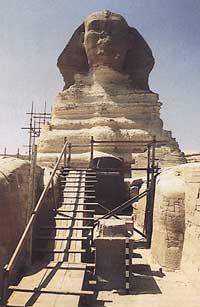
In the last two centuries numerous investigations and excavations have been carried out; experts who have accompanied Napoleon in 1798, Caviglia in 1816, H. Vyse in 1840, Mariette in 1853, Maspero in 1855, Kanala eta Daressy in 1909 and Baraize in 1926, among other examples. The latter researcher removed the sand that covered the body of the Sphinx and discovered that the statue was cut through the center. He arranged his head with cement and left a collection of 226 photographs of the work done.
In recent years, the repair work carried out in 1953 has been highlighted. Scientists Lehner and Hawass conducted an interesting study in 1978. Finally, in 1982 there was the fall of some stones of the north claw, replacing the walls and small of the Roman era with new and greater ones. Cement was used in the joints between stones and now cement has become the main problem.
Problems of esfing
Esfing is mainly made up of limestones and, like all materials on the earth's surface, is subjected to the action of water, air and living beings. The processes of all these external agents make materials change and translate. This action is called weathering and can be mechanical or chemical. In the first case, the material is broken without producing alterations in its composition. In the second case the chemical modification is carried out. At any point on the Earth's surface, both meteorizations will act simultaneously, but one will be more important than others depending on the local climate.
Egypt's relative humidity is very low (15% on average). The amount of rainfall collected in Alkaire is only 24 mm. Consequently, as it is not attenuated by the humidity of the air, the earth suffers strong temperature variations. As soon as dawn, sand and words begin to heat radiating heat to the surrounding dry air.
If the tourist sits on the stones of the pyramid to enjoy the wonderful landscape surrounding the pyramids and rest, he will soon notice the effects we just mentioned. When the sun sets, the air cools sharply and the rocks lose heat. Due to these heating and cooling processes, the stones expand and contract, fractures may occur depending on the elasticity of the materials (see table Average temperatures measured in Alkaire).
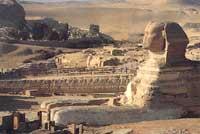
Another problem of esfing is that of water. If at dawn there is little water in the rock, the heat of the day will cause evaporation of the water and the salts dissolved in the water precipitate meteorizing the limestone, so the stone will go undone. In addition to the continued effect of moisture and heat, erosion of meteorized fragments must be taken into account, due to the influence of the grains of sand transported by the wind. The grains of sand present collisions against the rock and because the rock is disintegrated, transport can be carried out easily.
All these processes that have deteriorated the Sphinx over the centuries should have the same influence throughout the state. However, an unskilled person may immediately notice that the chest is much more affected than the head. To find the reason for this effect, we must remember that the state body has been covered with sand for hundreds of years. In these conditions the surface water is filtered and, as it is not evaporable, the limestone will be diluted, being able to produce other chemical alterations.
We must take into account not only all the effects we have mentioned so far, but also humans. Fortunately, Esfing is no longer used for shooting practices, but air pollution gases cause rapid chemical weathering. It should be mentioned that the layer of smog that fouls the wonderful blue sky color daily surrounds Alkairo. Also, instead of the camels that only a few decades ago traveled the area of the Pyramid, today you can see a large number of buses for tourists. In order to check the damage caused by pollution, there is only look at the engravings of the last century. Buruzapiko's image is about to disappear!
The last problem associated with esfing is due to man-made trials to prevent deterioration of the state. In the 1982 repair works, cement was used to make connections of new limestones instead of old stones. Because they are different materials, their behaviour towards external agents is different, so the weathering suffered will not be the same either. In conclusion, changes can be seen in the form of Esfing. Therefore, some state restoration processes have caused more damage than improvements!
Current restoration
In 1988 a large stone fell from the shoulder of Esfing and in 1989 repair began. This work was done under the direction of Sayed Tawfic, a member of the Egyptian Archaeological Organization. It should be noted that his generosity and responsibility have been of vital importance in the resolution. Also the Minister of Culture, Farou Hosni, promoted the project. The artistic sensitivity of this man allowed him to add a sculptor to the team of archaeologists, geologists and other scientists. The project was divided into three sections: Restoration South, Restoration North and Chest and special treatment of the entire statue, in order to protect it from deterioration caused by elements of the environment.
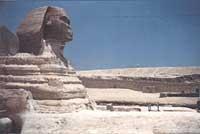
To carry out the work corresponding to the South, they took into account the investigations of Lehner and the German Institute of Alkairo. Ancient photographs and drawings of the Sphinx were also used, which could reveal details that are almost erased today.
Large old stones and cement were removed and worked directly on the rock. The compatibility of the new stones from the fortress of Helwan with the calero was studied using precise chemical analysis and were used to fill the gaps once their compatibility has been verified. The cement was replaced by a mass of sand and limestone. Today, both the South and the most fragile parts of the body are repaired.
The Helwan Institute of Astronomy and Geophysics has analyzed groundwater level. Currently the level is seven meters below the state base. In addition, the Getty Institute has created an electronic weather station in which humidity, temperature and wind data are collected. On the other hand, a group of UNESCO scientists conducted research through sonar to know the situation of the state leader. The conclusions of this study indicate that the head does not need burr support and is not in danger. The Faculty of Engineers of the University of Alkairo also joined the conservation and restoration work, assuming the study of the base rock under Esfing.
Before beginning the work of the second paragraph mentioned above, Minister Hosni organized a general meeting on the protection of Esfing. This meeting took place in Alkairo and for a few days had 90 representatives, half foreign. Scientists, historians, geologists, chemists, artists and environmental experts, among others, participated in the event with the aim of saving Esfing. The main objectives of the meeting were the detection of state damage and, above all, the search for ways to avoid future damage.
The importance of the plan of restoration of the esfing, the Egyptian minister stressed at the end of the meeting with the following words: ...Esfing is not just Egyptian. It is a heritage of humanity, legacy for future generations, to be preserved and cared for...
Last word
Esfing remains a mystery, except in the hands of experts. His smile will be eternal. If you have not yet been able to see him, try to visit him, perhaps you discover the enigma of Esfing. ...
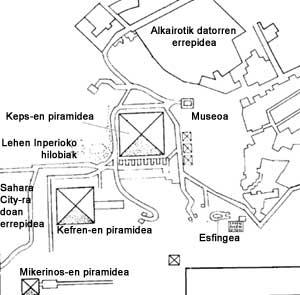
| Jan | Feb | Sea | Abr | May | Jun. | Jul Jul | August | Sep | Oct | November | Dec | |
• |
197 |
2024 |
2410 |
2813 |
3216 |
3520 |
3521 |
3521 |
3120 |
2917 |
Other |
209 |
(*) Average temperatures are in degrees Celsius and are taken in the shade. The maximum temperatures measured in the sun, especially in summer, are significantly higher than those indicated in the table.

Gai honi buruzko eduki gehiago
Elhuyarrek garatutako teknologia




